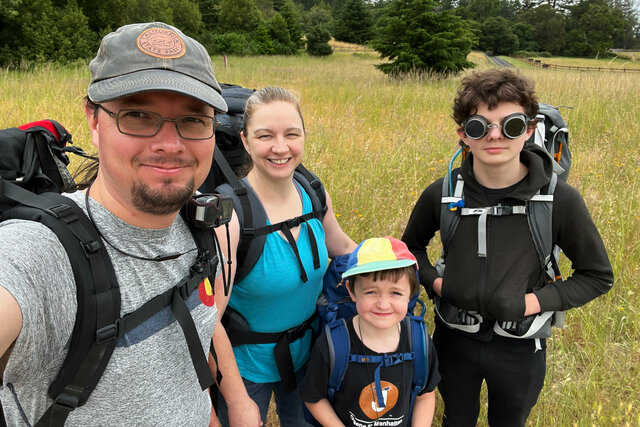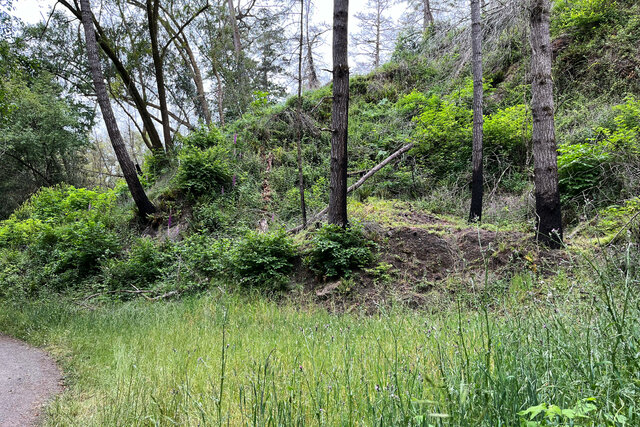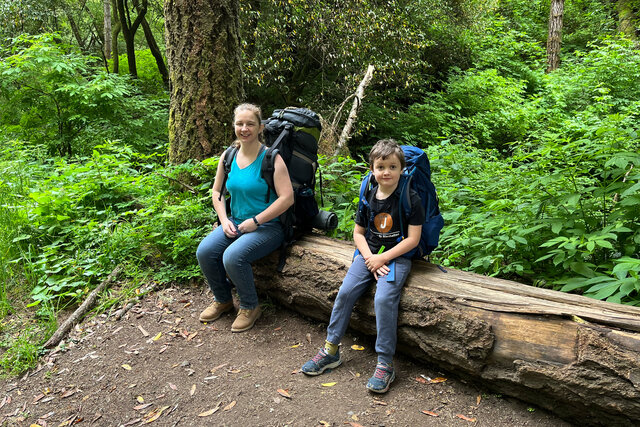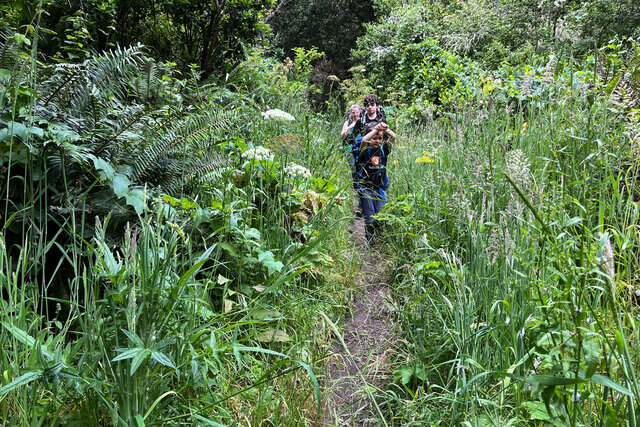Glen Camp
Started: 2023-06-19 20:07:02
Submitted: 2023-06-19 21:19:33
Visibility: World-readable
Hiking into the wilderness to camp at Point Reyes
On Friday, the 9th of June, we set out on a three-day, two-night backpacking expedition to Glen campground in Point Reyes National Seashore.
Glen campground was a 4.5-mile hike from the Bear Valley Trailhead. We ate lunch at the trailhead, then walked around the short earthquake loop interpretive trail, which crosses the San Andreas Fault and shows where a fence had been split apart in the ground rupture during the 1906 earthquake. (This led me to wonder how property boundaries would be affected by seismic activity: does the land holding follow the movement of the ground, or does it follow the imaginary line where a surveyor would place the marker, if recreating it from scratch?)
Point Reyes is a dramatic outcropping sticking out into the Pacific Ocean on rock that isn't really supposed to be there, because it followed the Pacific Plate north hundreds of miles from its origin to the south. But this is no longer quite as novel since we live in Santa Cruz, which is also on the ocean's side of the fault, also creeping northward at an inch per year.
We set out on the trail, following the Bear Valley Trail into the hills making up the bulk of the eastern arm of the seashore. The trail was really a dirt road that had been excluded from the adjacent wilderness area, allowing the Park Service to maintain a pit toilet along the road, and making it possible to bike to the end of the road, half-way down the valley to the beach. The day was overcast and humid; it probably would have approached muggy if it had been much warmer. The trail took us up a narrow valley surrounded by forest on both sides. The forest was a mixture of deciduous and evergreen trees, with patches of stinging nettles reaching out from the underbrush by the trail (where they hadn't been weed-whacked, apparently by the Park Service's trail crews) and poison oak lurking just out of reach off the trail.
Some of the hillside to our right as we hiked had been burned in a fire in 2020. (In some places it looked like the road itself was the break where the fire stopped.) Burn marks were clearly visible on trees, and the hillside looked somewhat thinner than elsewhere, but the underbrush was growing back, with the assistance of the wet winter.
We crossed a saddle point at Divide Meadow and began a gentle descent down the opposite side, down a nearly identical narrow valley with a nearly-identical creek. The only difference was that we were descending, and the creek drained directly into the Pacific Ocean somewhere ahead of us, instead of Tomales Bay somewhere behind us.
We reached a four-way junction at the edge of the wilderness. There was a bike rack in case anyone wanted to lock their bikes and continue on foot into the body of the wilderness (which banned bikes, because they're mechanized transport). We stopped for a rest and a snack at a conveniently-placed log. (Julian wanted to rest with some frequency during the hike, and I attempted to call off every two kilometers that we walked, according to my GPS receiver, as a longer rest. Both of the kids had Camelback hydration bladders in their backpacks, with spouts for easy access strapped to their shoulder straps. I encouraged them to drink as much water as they could.)
From the four-way junction, we turned off the road and onto the Glen trail, which crossed the creek on a sturdy bridge then began a steep ascent of the hill on the other side. I tried to set an easy pace up the hill, but even carrying the heaviest pack in the family I was still faster than Julian. (Julian was not unladen; he had some trouble figuring out how to balance while wearing his backpack and kept trying to stand straight up, at which point his backpack would pull him backwards and he would start to fall.)
The trail leveled out and entered a single-track section. In places the grasses (and stinging nettles) next to the trail were encroaching on the trail). I found an appropriately-sized stick for Kiesa, and she took the lead, beating the stinging nettles into submission on both sides of the trail, where it looked like we might come into contact with them. Everyone was wearing long pants, but it was too warm for long sleeves.
We reached the campground late in the afternoon, and it looked like we were the first people to arrive at any of the twelve sites. I picked site #2, because it looked like a good site from the pictures and map on the Park Service's website (close to the pit toilet, but not too close; sheltered under a massive oak tree). By backpacking standards, this was luxury: our site had a huge flat space to set up the tent, plus a large picnic table, and a large box to store our food in (large enough to store all of our backpacks, which was handy, because we our tent was cozy). The campground had running potable water, trash service, and a sturdy, concrete-vault pit toilet. All of this was made possible by the dirt service road. It almost felt like we were backpacking on easy mode.
I set up the tent, with some help from the kids, then set up the sleeping bags inside the tent. Calvin's new Big Agnes air mattress came with an inflation sack, which had a valve at one end that attached to the mattress, and was open at the other end. I figured out that I could pull the sides open to trap air inside the sack, then fold the top over and roll the end down to squeeze the air from the sack into the mattress. It was a little awkward at first, but I got the hang of it, and it was actually faster and easier than blowing air into the tiny valves on everyone else's older air-core mattresses.
We brought backpacking meals for supper, plus hot chocolate to drink immediately after supper. The picnic table looked like it was built out of recycled plastic, and it had a panel bolted to one end embossed with the suggestion that we put our hot plates there, rather than elsewhere on the table, presumably to avoid melting the plastic.
By the time we had eaten and were ready to retire to the tent, other people began arriving at the campground. (Almost everyone else looked like they were young adults; it looked like we were the only family staying there for the night.) One group brought a string of lights (presumably battery-powered LEDs) and strung it up above their campsite, which seemed like an interesting idea, and certainly not anything I wanted to spend my weight budget on.
Inside our four-person tent was cozy with four people. Our sleeping bags covered the entire width of the floor, leaving only a narrow strip at our heads to enter and exit the tent via the main door and vestibule. (Julian's sleeping bag was shorter than everyone else's, but he still had a 20-inch-wide pad. Calvin had a super-sized 25-inch-wide pad, which mostly meant that his bag didn't overhang off the side of his pads like everyone else's.)
Kiesa brought a movie on her iPad to watch (along with headphones and splitters), which was only slightly awkward to watch while scrunched up in a small tent without a lot of elbow room. By the time the movie finished it was dark, which seemed like a good enough time to go to bed for the night.











